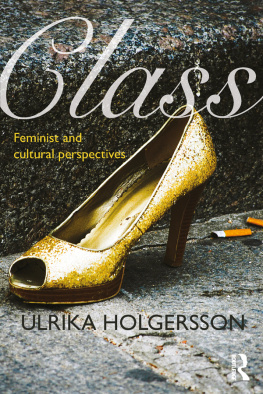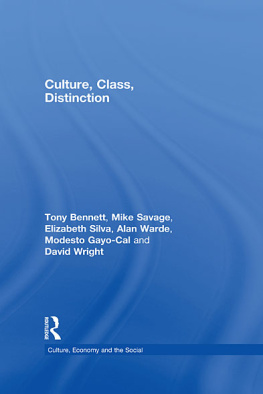First published 1995 by Harvester Wheatsheaf
Published 2013 by Routledge
2 Park Square, Milton Park, Abingdon, Oxon OX14 4RN
711 Third Avenue, New York, NY 10017, USA
Routledge is an imprint of the Taylor & Francis Group, an informa business
Richard Breen and David B. Rottman, 1995
All rights reserved. No part of this book may be reprinted or reproduced or utilised in any form or by any electronic, mechanical, or other means, now known or hereafter invented, including photocopying and recording, or in any information storage or retrieval system, without permission in writing from the publishers.
Notices
Knowledge and best practice in this field are constantly changing. As new research and experience broaden our understanding, changes in research methods, professional practices, or medical treatment may become necessary.
Practitioners and researchers must always rely on their own experience and knowledge in evaluating and using any information, methods, compounds, or experiments described herein. In using such information or methods they should be mindful of their own safety and the safety of others, including parties for whom they have a professional responsibility.
To the fullest extent of the law, neither the Publisher nor the authors, contributors, or editors, assume any liability for any injury and/or damage to persons or property as a matter of products liability, negligence or otherwise, or from any use or operation of any methods, products, instructions, or ideas contained in the material herein.
ISBN 13: 978-0-7450-1268-1 (pbk)
Library of Congress Cataloging-in-Publication Data
Breen, Richard, 1954
Class stratification: a comparative perspective / Richard Breen and David B. Rottman.
p.cm.
Includes bibliographical references and index.
ISBN 0-7450-1268-X
1. Social classes.I. Rottman, David B.II. Title.
HT609.B741995
305.5dc20 94-29721
CIP
British Library Cataloguing in Publication Data
A catalogue record for this book is available from the British Library
ISBN: 0 7450 1268 X
In this book we develop a new approach to the sociological study of stratification. The novelty arises primarily because our starting point is the behaviour of individuals and secondarily because the scope of our presentation is broadly international. These claims call for some preliminary words to explain why we believe that the result is an enhanced understanding of social stratification.
The need for elaboration and justification is strongest for the attention we place on the behaviour of individuals. Stratification is concerned with groups, and it may seem indeed is an unusual step to devote the initial chapter of our book to the behaviour of individuals. Now groups, of course, consist of individuals, and it is common to assert that all social phenomena must ultimately be understood as the product of the actions and interaction of individuals (e.g. Elster 1989:13). What is rare is for the micro-sociological foundations of stratification theory to be so clearly detailed and then used to explain why persons in a group share a number of attributes including similar chances for material success. Briefly, the essence of stratification is that individuals are unequally located within a structure of social power. By social power we mean the set of resources individuals possess to enable them to pursue certain sorts of actions and the constraints they face in doing so. Social stratification in our approach seeks to explain the bases through which individuals come to share particular positions of social power. In advanced societies, those bases include gender, ethnicity, and class. Our focus is on class, the position of social power that derives from location in the production process. Class is the most important determinant of life chances because it directly links individuals to the economic order.
The payoff from explaining all of this at the outset is a clearer picture of what a class is and why class is so important. We hope that, as a result, readers will be able to understand how the often nebulous concept of class affects their lives. This contrasts with accounts of class that begin at the group level and thus leave unanswered the question of why being a member of a social class has particular consequences. Students of stratification often sound almost apologetic for persisting in emphasizing the idea of social class in an era where the term has largely slipped out of everyday usage. This is unnecessary. Contemporary theories can often be uncertain guides as to where we should expect class to matter precisely because they lack a grounding in individual behaviour.
One upshot of laying a solid foundation in the behaviour of individuals is a rigorous and transparent definition of class stratification for use when describing and analyzing the class structure of nations. This leads to the second novel feature of the book. We adopt an explicitly comparative perspective. The potential of the study of social stratification, and particularly class stratification, is most importantly realized in what it can tell us about similarities and differences among nations. Fundamentally, nations differ in the bases of social power around which groups are likely to form. The understanding that we have of how the behaviour of individuals is linked to class position offers insight into the divergent patterns of openness or closure observed in various countries and the degrees of distributional conflict present.
We proceed to examine some of the main points of similarity and difference among the advanced industrial societies. To do so, we draw upon the considerable body of comparable data on national class structures and patterns of social mobility.
To describe and compare class structures requires theories that tell us how social classes are defined and the procedures for allocating people to classes. With takes up the ideas of two prominent contemporary class theorists and explains how each moves from their theoretical concepts to specific instructions for placing individuals into class positions.
Class is a central theoretical concept in sociology. looks at class in geographical perspective by considering the extent to which a nations position within the world economy and political order has implications for the class structure that prevails. In short, what is the relationship between class stratification within a nation and that nations place in the world order?
The theoretical and empirical status of class is currently under challenge. In we consider these critiques of class analysis and assess the merits of claims being made for the primacy of alternative bases of stratification such as race.
The concluding chapter is concerned more with looking forward than with reviewing what has already been presented and debated. As is standard in concluding chapters, we propose issues and problems, both theoretical and methodological, that merit attention. But we concentrate on the enduring relevance of class as an analytical tool for understanding contemporary societies, as well as the shape of our individual lives. The social class into which we are born remains vastly influential in shaping our life course and life chances, even in the waning years of the twentieth century.






